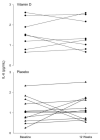Vitamin D supplementation during exercise training does not alter inflammatory biomarkers in overweight and obese subjects
- PMID: 22183086
- PMCID: PMC3417103
- DOI: 10.1007/s00421-011-2279-3
Vitamin D supplementation during exercise training does not alter inflammatory biomarkers in overweight and obese subjects
Abstract
The purpose of this study was to examine the effects of vitamin D supplementation on inflammatory biomarkers in overweight and obese adults participating in a progressive resistance exercise training program. Twenty-three (26.1 ± 4.7 years) overweight and obese (BMI 31.3 ± 3.2 kg/m2) adults were randomized into a double-blind vitamin D supplementation (Vit D 4,000 IU/day; female 5, male 5) or placebo (PL, female 7; male 6) intervention trial. Both groups performed 12 weeks (3 days/week) of progressive resistance exercise training (three sets of eight exercises) at 70-80% of one repetition maximum. Whole-blood lipopolysaccharide (LPS)-stimulated tumor necrosis factor (TNF) α production as well as circulating C-reactive protein (CRP), TNFα, interleukin 6 (IL-6), and alanine aminotransferase (ALT) were assessed at baseline and after the 12-week intervention. No main effects of group or time were detected for circulating CRP, TNFα, IL-6, and ALT. As expected, when PL and Vit D groups were combined, there was a significant correlation between percent body fat and CRP at baseline (r = 0.45, P = 0.04), and between serum 25OHD and CRP at 12 weeks (r = 0.49, P = 0.03). The PL group had a significant increase in 25 μg/ml LPS + polymixin B-stimulated TNFα production (P = 0.04), and both groups had a significant reduction in unstimulated TNFα production (P < 0.05) after the 12-week intervention. Vitamin D supplementation in healthy, overweight, and obese adults participating in a resistance training intervention did not augment exercise-induced changes in inflammatory biomarkers.
Figures



Similar articles
-
Effects of a 1-year supplementation with cholecalciferol on interleukin-6, tumor necrosis factor-alpha and insulin resistance in overweight and obese subjects.Cytokine. 2012 Dec;60(3):870-4. doi: 10.1016/j.cyto.2012.07.032. Epub 2012 Aug 24. Cytokine. 2012. PMID: 22925537 Clinical Trial.
-
Large Doses of Vitamin D Fail to Increase 25-Hydroxyvitamin D Levels or to Alter Cardiovascular Risk Factors in Obese Adolescents: A Pilot Study.J Adolesc Health. 2015 Jul;57(1):19-23. doi: 10.1016/j.jadohealth.2015.02.006. Epub 2015 Apr 11. J Adolesc Health. 2015. PMID: 25873553 Clinical Trial.
-
Vitamin D supplementation does not alter inflammatory markers in overweight and obese individuals: A systematic review and meta-analysis of randomized controlled trials.Nutr Res. 2024 Aug;128:24-37. doi: 10.1016/j.nutres.2024.06.005. Epub 2024 Jun 17. Nutr Res. 2024. PMID: 39002359
-
Concurrent alteration in inflammatory biomarker gene expression and oxidative stress: how aerobic training and vitamin D improve T2DM.BMC Complement Med Ther. 2022 Jun 22;22(1):165. doi: 10.1186/s12906-022-03645-7. BMC Complement Med Ther. 2022. PMID: 35733163 Free PMC article. Clinical Trial.
-
Effect of Vitamin D Supplementation on Some Inflammatory Biomarkers in Type 2 Diabetes Mellitus Subjects: A Systematic Review and Meta-Analysis of Randomized Controlled Trials.Ann Nutr Metab. 2018;73(1):62-73. doi: 10.1159/000490358. Epub 2018 Jun 26. Ann Nutr Metab. 2018. PMID: 29945132
Cited by
-
Effects of different exercise modalities on inflammatory markers in the obese and overweight populations: unraveling the mystery of exercise and inflammation.Front Physiol. 2024 Jun 12;15:1405094. doi: 10.3389/fphys.2024.1405094. eCollection 2024. Front Physiol. 2024. PMID: 38933362 Free PMC article. Review.
-
Vitamin D and Weight Cycling: Impact on Injury, Illness, and Inflammation in Collegiate Wrestlers.Nutrients. 2016 Nov 30;8(12):775. doi: 10.3390/nu8120775. Nutrients. 2016. PMID: 27916879 Free PMC article.
-
An Exploratory Critical Review on TNF-α as a Potential Inflammatory Biomarker Responsive to Dietary Intervention with Bioactive Foods and Derived Products.Foods. 2022 Aug 21;11(16):2524. doi: 10.3390/foods11162524. Foods. 2022. PMID: 36010524 Free PMC article. Review.
-
The Effects of 12 Weeks Regular Aerobic Exercise on Brain-derived Neurotrophic Factor and Inflammatory Factors in Juvenile Obesity and Type 2 Diabetes Mellitus.J Phys Ther Sci. 2014 Aug;26(8):1199-204. doi: 10.1589/jpts.26.1199. Epub 2014 Aug 30. J Phys Ther Sci. 2014. PMID: 25202180 Free PMC article.
-
C-Reactive Protein and Resistance Exercise in Community Dwelling Old Adults.J Nutr Health Aging. 2015 Aug;19(7):792-6. doi: 10.1007/s12603-015-0548-2. J Nutr Health Aging. 2015. PMID: 26193865 Clinical Trial.
References
-
- Armstrong L, Balady G, Berry M, Davis S, Davy B, Davy K, Franklin B, Gordon N, Lee I, McConnell T, Myers J, Pizza F, Rowland T, Stewart K, Thompson P, Wallace J. ACSM’s Guidelines for Exercise Testing and Prescription. Seventh Edition Lippincott Williams & Wilkins; Philadelphia: 2006.
-
- Bjorkman MP, Sorva AJ, Tilvis RS. C-reactive protein and fibrinogen of bedridden older patients in a six-month vitamin D supplementation trial. J Nutr Health Aging. 2009;13:435–439. - PubMed
-
- Cigolini M, Iagulli MP, Miconi V, Galiotto M, Lombardi S, Targher G. Serum 25-hydroxyvitamin D3 concentrations and prevalence of cardiovascular disease among type 2 diabetic patients. Diabetes Care. 2006;29:722–724. - PubMed
Publication types
MeSH terms
Substances
Grants and funding
LinkOut - more resources
Full Text Sources
Medical
Research Materials
Miscellaneous

